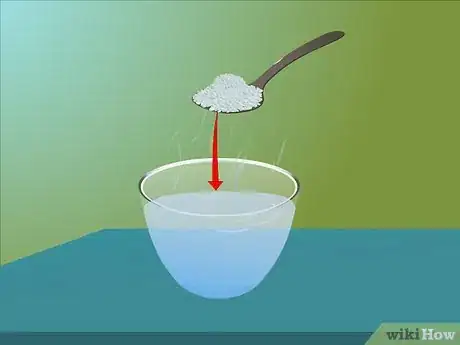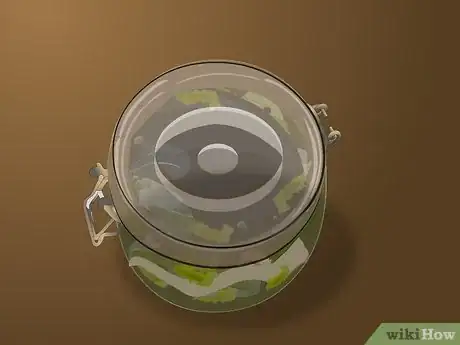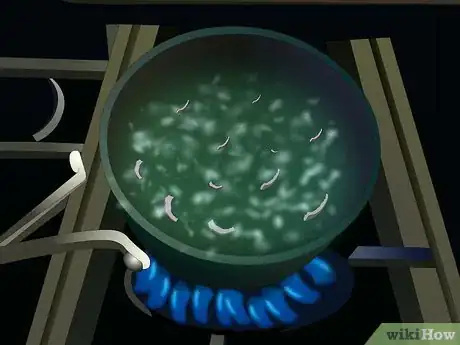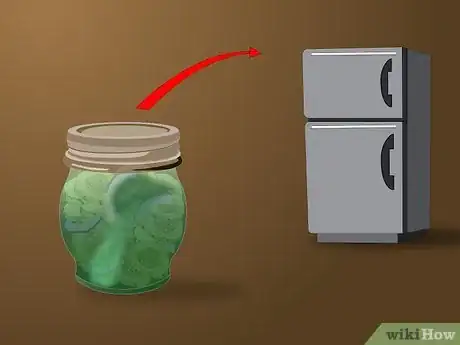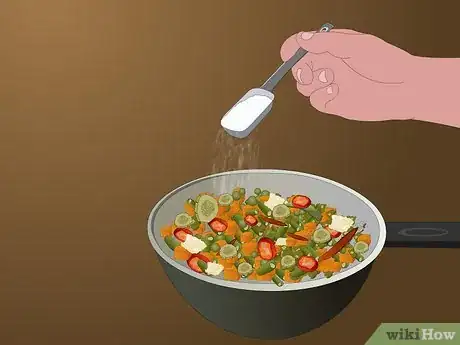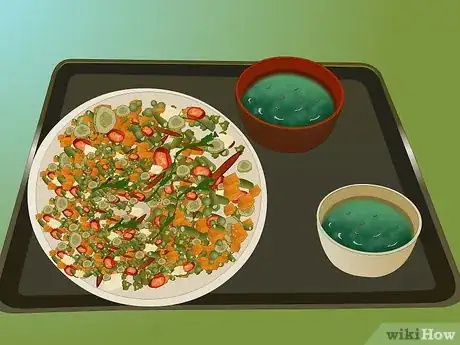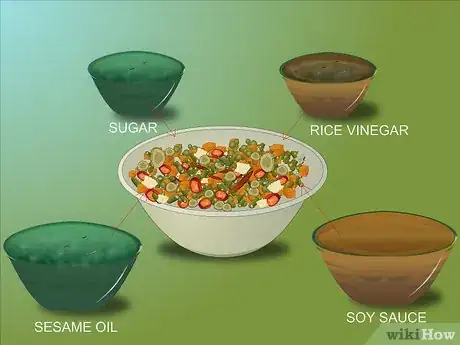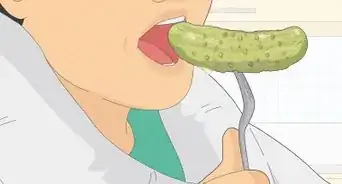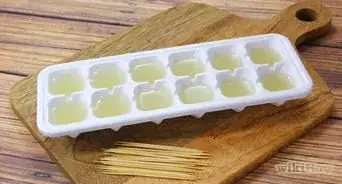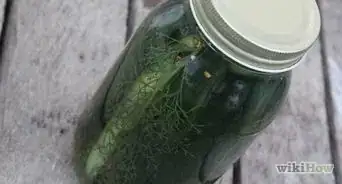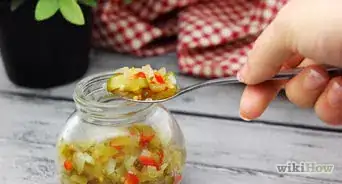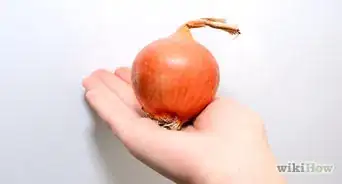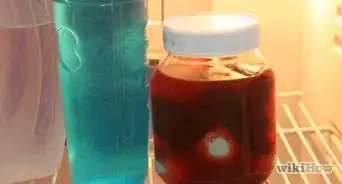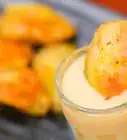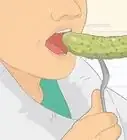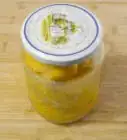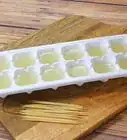wikiHow is a “wiki,” similar to Wikipedia, which means that many of our articles are co-written by multiple authors. To create this article, 17 people, some anonymous, worked to edit and improve it over time.
This article has been viewed 25,842 times.
Learn more...
Pickling is one of the oldest methods of preserving food. Pickling is accomplished by preserving food using an acid, such as vinegar, or fermenting food in a salty brine which creates conditions for the formation of lactic acid. When you mention making pickles, cucumbers most commonly come to mind, but many fruits and vegetables can be pickled. This article describes several recipes to help you get started pickling.
Ingredients
Makes 15 pickle halves
- ⅓ cup kosher salt
- 1 cup boiling water
- 2 lbs. small “pickling” cucumbers, washed and cut in half the long way
- 5 cloves of garlic, mashed
- 1 large bunch fresh dill with flowers (or 2 Tbs. dried dill and 1 tsp. dill seeds)
Makes 6 cups
- 3 cups sliced peeled cucumbers
- 3 cups sliced peeled yellow summer squash
- 2 cups chopped sweet onions
- 1½ cups white vinegar
- 1 cup sugar
- ½ tsp. salt
- ½ tsp. celery seed
- ½ tsp. mustard seed
Makes 4 servings
- 1 lb. cucumber, zucchini, summer squash or eggplant
- 1 Tbs. salt
- ½ tsp. sugar
- 1 Tbs. minced fresh dill or 1 tsp. dried dill
- 2 tsp. any vinegar
Steps
Kosher Dill Pickles [1]
-
1Wash the cucumbers.
-
2Combine salt and boiling water in a large bowl or crock. Stir to dissolve the salt.
- Kosher salt is a very coarse grain salt which does not contain iodine or any anti-caking additives.
- Do not substitute table salt. Table salt is fine-grained and usually contains iodine and an anti-caking additive. The additives in table salt may leave a bitter taste, darken the color, and cause the brine to become cloudy.
- You can pickle in food grade plastic, stainless steel and glass. Containers made of aluminum or copper should not be used for pickling
Advertisement -
3Once the salt is dissolved, add a handful of ice cubes to cool the mixture.
-
4Cut the cucumbers in half lengthwise.
-
5Add the cucumbers, garlic, dill and enough cold water to submerge.
-
6Using a plate slightly smaller than your container, place the plate and a small weight on top of the cucumber mixture. This will keep the cucumbers under water.
- Use a clean rock, or anything heavy enough to keep the cucumbers under water.
- Keep the mixture at room temperature.
-
7After 10 hours, sample the pickles. It will take anywhere from 24 - 48 hours for the pickling process to be complete.
-
8When the pickles are suitable for your taste, refrigerate them in the brine.
- The pickles will continue to ferment, but more slowly in the refrigerator
- The pickles will keep for up to a week in the refrigerator
Refrigerator Pickles [2]
-
1Wash the cucumber and summer squash.
-
2Peel cucumbers and summer squash. Cut into slices approximately ¼ inch in diameter.
- If you prefer you may use thinner or thicker slices. The cucumber and summer squash should be about the same thickness.
-
3Place cucumbers, summer squash and sweet onions in a bowl.
- You can pickle in food grade plastic, stainless steel or glass.
- Aluminum and copper are not suitable for pickling.
-
4Combine vinegar, sugar, salt, celery seed and mustard seed in a small saucepan. Bring to a boil.
-
5Cook and stir just until sugar is dissolved.
-
6Pour mixture over cucumbers. Cool.
-
7Cover tightly and refrigerate for at least 24 hours.
Quick Pickled Vegetables [3]
-
1Wash the vegetables.
-
2Slice the vegetables as thinly as possible. Vegetables can be peeled or left unpeeled.
- A mandolin is excellent for this.
- Be sure to use the guard and be careful to avoid slicing your fingers if using a mandolin.
-
3Place the vegetables in a colander and salt them.
-
4Toss the sliced vegetables with the salt, working the salt into the vegetables with your hands for a minute.
-
5Let the vegetables sit in the colander for 15 - 30 minute, tossing and squeezing every few minutes.
- Continue until little to no liquid can be squeezed out of the vegetables
- Cucumbers take less time; eggplant takes more time.
-
6Rinse the vegetables well in cold water.
-
7Place in a bowl.
- You can pickle in food grade plastic, stainless steel or glass.
- Aluminum and copper are not suitable for pickling.
-
8Add the sugar, dill and vinegar to the vegetables.
-
9Serve immediately. Quick pickled vegetables do not keep well.
-
10Vary the recipe if you'd like with this Asian-style twist. Instead of the sugar, dill and vinegar in Step 8, add ½ tsp. sugar, ½ tsp. dark sesame oil, 1Tbs soy sauce and 1 tsp. rice vinegar.
Things You'll Need
- Measuring spoons
- Vegetable peeler
- Slicing Knife
- Mandolin (optional)
- Cutting board
- Colander
- Bowl, Bucket or Crock made of food grade plastic, stainless steel or glass
- Plate with a diameter smaller than bowl, bucket or crock
- Heavy weight (e.g. clean rock, large heavy can of beans or other food)
- Small saucepan
- Mixing spoon
References
- ↑ Bittman, Mark. How to Cook Everything. Wiley Publishing, 1998.
- ↑ http://www.tasteofhome.com/Recipes/Refrigerator-Pickles/
- ↑ Bittman, Mark. How to Cook Everything. Wiley Publishing, 1998.
About This Article
To quick pickle vegetables, first wash your vegetables and slice them as thinly as you can. Then, put your vegetables in a colander, add a tablespoon of salt, and use your hands to work the salt into the vegetables. Let your vegetables sit in the colander, and squeeze them every few minutes to remove excess water. When no more water comes out, rinse your vegetables in cold water and put them in a bowl. Season them with sugar, dill, and vinegar before you serve them immediately. To learn how to pickle kosher dill pickles or refrigerator pickles, keep reading!

